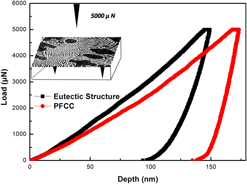Crossref Citations
This article has been cited by the following publications. This list is generated based on data provided by
Crossref.
Rahul, M. R.
and
Phanikumar, Gandham
2019.
Design of a Seven-Component Eutectic High-Entropy Alloy.
Metallurgical and Materials Transactions A,
Vol. 50,
Issue. 6,
p.
2594.
Tsau, Chun-Huei
Yeh, Chen-Yu
and
Tsai, Meng-Chi
2019.
The Effect of Nb-Content on the Microstructures and Corrosion Properties of CrFeCoNiNbx High-Entropy Alloys.
Materials,
Vol. 12,
Issue. 22,
p.
3716.
Kumar, Saurav
Patnaik, Amar
Pradhan, Ajaya Kumar
and
Kumar, Vinod
2019.
Room temperature wear study of Al0.4FeCrNiCox (x = 0, 0.25, 0.5, 1.0 mol) high-entropy alloys under oil lubricating conditions.
Journal of Materials Research,
Vol. 34,
Issue. 5,
p.
841.
Rogachev, A. S.
2020.
Structure, Stability, and Properties of High-Entropy Alloys.
Physics of Metals and Metallography,
Vol. 121,
Issue. 8,
p.
733.
Li, Na
Gu, Ji
Gan, Bin
Qiao, Qiao
Ni, Song
and
Song, Min
2020.
Effects of Mo-doping on the microstructure and mechanical properties of CoCrNi medium entropy alloy.
Journal of Materials Research,
Vol. 35,
Issue. 20,
p.
2726.
Zhang, Wanying
Yan, Dingshun
Lu, Wenjun
and
Li, Zhiming
2020.
Carbon and nitrogen co-doping enhances phase stability and mechanical properties of a metastable high-entropy alloy.
Journal of Alloys and Compounds,
Vol. 831,
Issue. ,
p.
154799.
An, Xulong
Chu, Chengling
Zhao, Hui
Shen, Baolong
Zhou, Liang
and
Chu, Paul K.
2020.
CoNiFeNb0.45 eutectic multi-principal element alloy with excellent mechanical properties and corrosion resistance.
Materials Science and Engineering: A,
Vol. 777,
Issue. ,
p.
139026.
Sinha, Agnivesh Kumar
Soni, Vinay Kumar
Chandrakar, Rituraj
and
Kumar, Anil
2021.
Influence of Refractory Elements on Mechanical Properties of High Entropy Alloys.
Transactions of the Indian Institute of Metals,
Vol. 74,
Issue. 12,
p.
2953.
Wen, Xin
Cui, Xiufang
Jin, Guo
Liu, Yufei
Zhang, Ye
and
Fang, Yongchao
2021.
In-situ synthesis of nano-lamellar Ni1.5CrCoFe0.5Mo0.1Nbx eutectic high-entropy alloy coatings by laser cladding: Alloy design and microstructure evolution.
Surface and Coatings Technology,
Vol. 405,
Issue. ,
p.
126728.
Liu, Xuechao
Wang, Haifeng
Liu, Yi
Wang, Canming
Song, Qiang
Cui, Hongzhi
Zhang, Chunzhi
and
Huang, Kun
2021.
The effect of Nb content on microstructure and properties of laser cladding 316L SS coating.
Surface and Coatings Technology,
Vol. 425,
Issue. ,
p.
127684.
Wang, Xin
Huang, He
Shi, Jie
Xu, Hai-Yan
and
Meng, Da-Qiao
2021.
Recent progress of tungsten-based high-entropy alloys in nuclear fusion.
Tungsten,
Vol. 3,
Issue. 2,
p.
143.
Shi, Hao
Fetzer, Renate
Jianu, Adrian
Weisenburger, Alfons
Heinzel, Annette
Lang, Fabian
and
Müller, Georg
2021.
Influence of alloying elements (Cu, Ti, Nb) on the microstructure and corrosion behaviour of AlCrFeNi-based high entropy alloys exposed to oxygen-containing molten Pb.
Corrosion Science,
Vol. 190,
Issue. ,
p.
109659.
Wen, Xin
Cui, Xiufang
Jin, Guo
Liu, Yufei
Zhang, Ye
Zhang, Xuerun
Liu, Erbao
Tian, Haoliang
and
Fang, Yongchao
2022.
Corrosion and tribo-corrosion behaviors of nano-lamellar Ni1.5CrCoFe0.5Mo0.1Nbx eutectic high-entropy alloy coatings: The role of dual-phase microstructure.
Corrosion Science,
Vol. 201,
Issue. ,
p.
110305.
Wang, Wenjie
Yang, Kaihuai
Wang, Qianting
Dai, Pinqiang
Fang, Hui
Wu, Fangjuan
Guo, Qiaohang
Liaw, Peter K.
and
Hua, Nengbin
2022.
Novel Ti-Zr-Hf-Nb-Fe refractory high-entropy alloys for potential biomedical applications.
Journal of Alloys and Compounds,
Vol. 906,
Issue. ,
p.
164383.
Yen, Chao-Chun
Tsai, Ting-Lun
Wu, Bo-Wei
Lo, Yu-Chieh
Tsai, Ming-Hung
and
Yen, Shiow-Kang
2022.
Dynamic Polarization Behaviors of Equimolar CoCrFeNi High-Entropy Alloy Compared with 304 Stainless Steel in 0.5 M H2SO4 Aerated Aqueous Solution.
Materials,
Vol. 15,
Issue. 19,
p.
6976.
Wang, Lu
Wang, Jiarui
Niu, Hongwei
Yang, Gongji
Yang, Lin
Xu, Mingqin
and
Yi, Jiaojiao
2022.
BCC+L21 dual-phase Cu40Al20Ti20V20 near-eutectic high-entropy alloy with a combination of strength and plasticity.
Journal of Alloys and Compounds,
Vol. 908,
Issue. ,
p.
164683.
Song, Pengfang
Jiang, Fulin
Wang, Yuling
Yang, Fazhan
and
Zhong, Zhaolin
2022.
Effect of energy density on the microstructure and properties of the CrFeCoNiNb high-entropy cladded layer.
The International Journal of Advanced Manufacturing Technology,
Vol. 118,
Issue. 11-12,
p.
3949.
Wu, Mingxu
Wang, Shubin
Xiao, Fei
Shen, Gaoyuan
Tian, Yusheng
Yang, Chao
Zhu, Guoliang
Wang, Donghong
Shu, Da
and
Sun, Baode
2022.
Designing lightweight dual-phase refractory VNbTiSi-based eutectic high-entropy alloys for use at elevated temperatures.
Materials Science and Engineering: A,
Vol. 842,
Issue. ,
p.
143112.
Zhang, Qi
Xu, Peng
Jiang, Tao
Li, Shaobo
Yu, Chuan
and
Yang, Daqing
2022.
Nb-doped FeMnSiCrNi coatings: microstructure, phase transformation, shape recovery rate, wear and corrosion resistance.
Optik,
Vol. 271,
Issue. ,
p.
170202.
Zhang, J. Y.
Xiao, B.
Chou, T. H.
Cao, B. X.
Zhao, Y. L.
Liu, B.
Huang, K.
Yang, S. B.
Su, J. C.
Liu, Y.
and
Yang, T.
2023.
High-Entropy Alloys: A Critical Review of Aqueous Corrosion Behavior and Mechanisms.
High Entropy Alloys & Materials,
Vol. 1,
Issue. 2,
p.
195.



